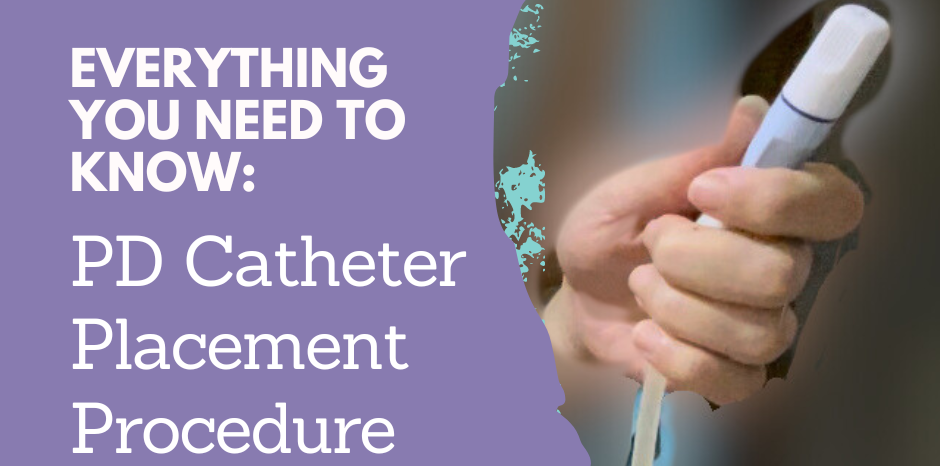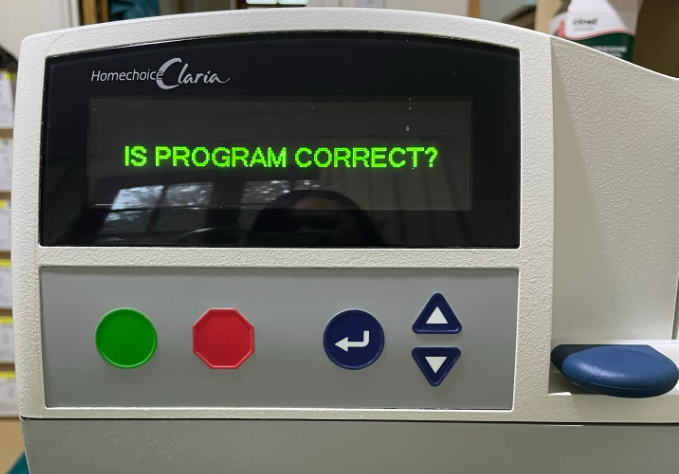Peritoneal Dialysis Stomach Catheter Line Change Appointment

Today I went to my PD Unit and had my Peritoneal Dialysis Catheter line changed by the nurses. This was a routine appointment that occurs approx. every 6 months.
The reason for this, as you may know if you have been on PD long enough, is that the catheter tube beyond the middle connection point can get a little grubby over time.
For this reason, I tend to quite enjoy having a catheter line change. It's got that fresh and new feeling to it. In the past, I have had my tube become discoloured to a green hue from new bedsheets. lol. I couldn't get the green out no matter how many times I cleaned it!
Other times, I have been desperate for a line change was when the iodine from the shield clamps leaked whilst I was connected and seeped into the grooves of the twist at the base of my blue catheter. It such a pain to clean safely, that I ended up just leaving it there which gave this dark black/brown hue to the blue base. It was kinda unsightly and unnerving because it looks like dirt, which just screams alarm bells to me for infection. But, it genuinely was ok because iodine is like antiseptic. Thankfully, I have had 2x changes since then and I am extra careful whenever I do have a iodine leak.
I believe the replacement of the second half of the catheter tube is likely to be out of hygiene purposes to reduce infection as well as to ensure that the plastics material doesn't degrade too significantly over time. In either case, it is definitely one of my favoured hospital appointments I routinely go to.
The Line Change
As mentioned above, the line change is only for the outer part of the PD catheter, specifically the second half of the thick plastic is where the blue connector is. It is quite a long and laboured process performed by the nurses in my clinic.
I shall now go on to describe what my experience has been of a line change. Let it be known, I am not a medical professional but these are just my observations:
(1) The Nurse normally gets out a number of items and begins set up on a table, as you the patient lies down on the bed.
(2) Hand washing protocol as usual followed by alcohol rub
(3) The Nurse then begins to open a number of packages and begin preparing gauze by dousing in a brown disinfectant.
(4) The Nurse reveals the stomach catheter from patients bandages from home and will inspect the exit site. She will also lay down some waxy paper or plastic type paper onto your stomach or thighs as a place to rest the catheter on. This is like a clean space for her to work on and also catch all the disinfectant! It drips everywhere.
(5) The Nurse usually soaks gauze in the brown disinfectant and wrap this around the exit wound and the catheter tube like where the tube and your stomach meet. Lucky me I had a perfect exit site, i.e no discoloration or pus and so I didn't need to be santised. This is a pretty messy process and can be quite cold! the disinfectant is kind of like iodine its this dark brown liquid that gets everywhere and stains the skin a bit.
(6) The Nurse performs a similar process at the thickened connection between tthe two halves of the catheter tube. The Nurse will wrap it in the soaked gauze. This is left for about a minute.
(7) Disconnection between the two halves of the tube occurs with a little tug! Hopefully not too hard on the tube that still connected to you.
(8) Connection of the new second half of the catheter!
(9) The Nurse cleans you up with a couple of alcohol wipes and dresses your exit site!
That's it! You now have a new catheter! Huzzah!
The entire process is over in less than 30 minutes 😊.
For me it is actually quite an enjoyable process. Afterall, I am the one that is normally cleaning and dressing myself every time I shower. So it's kinda nice to have someone do it for me. I liken it to having a Car MOT or Car Cleaning Service haha. Even better, they do a check over your exit site and give you a bit of once over, which can be quite reassuring in assessing how you are doing in terms of hygiene and exit site care.
I particularly enjoyed having my exit checked in the first few months of starting PD because it took absolutely ages for the stitches to fall out and the bruising and swelling to go down. I was following all the steps for PD set up and exit site management at home but it was really hard to tell if I was developing an exit site infection or not because it was always discoloured and sore. It was really great to have a Nurse just have a check every now and then for me. Thankfully, as of yet, I have not had any issues regarding my exit site!
Final Comments
I hope this short post demystified any qualms about what a Catheter Line Change Appointment is and there is nothing to be worried about if anything you should be excited at the prospect! It's a great time to ask catheter care questions with the nurses and any questions in general about PD.
Good Luck with your appointment! Lai
Consider following me on Instagram: @My_Kidney_and_Lai
If you DM to say you came from my website, I'd be thrilled to have a chat!
Tips
You wouldn't believe it but I have a few tips for this type of appointment.
Firstly, this procedure as you can tell is one that is a high risk of infection! You are basically undoing the tube that connects to your inner stomach and then attaching a new one. So that moment when you are unattached and open to the world, the Nurse needs to be really careful regarding cross contamination. Hence, all my tips relate to this fact!
Members Only
✔ Free Subscription
✔ No email alerts
✔ View Member's Only posts




